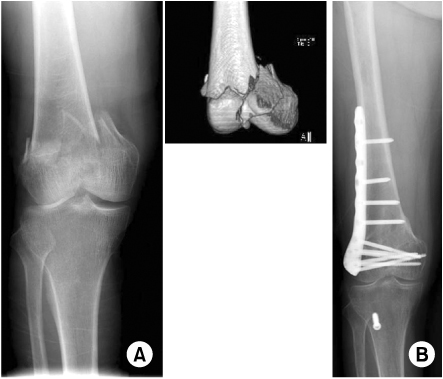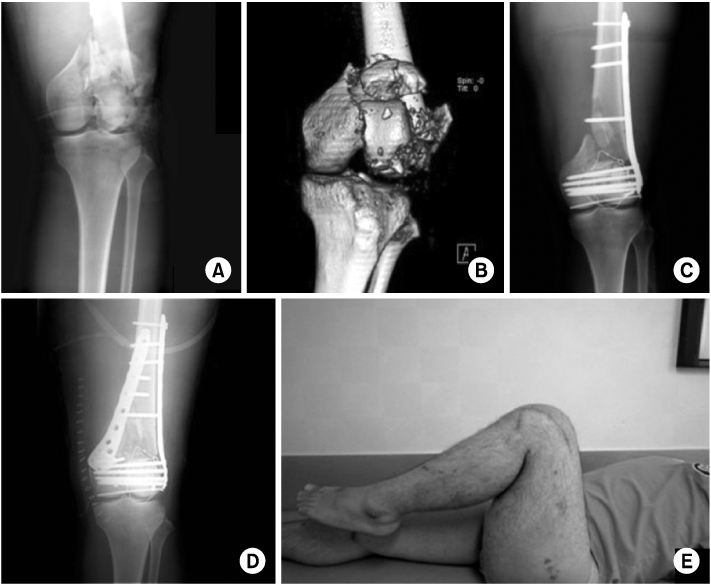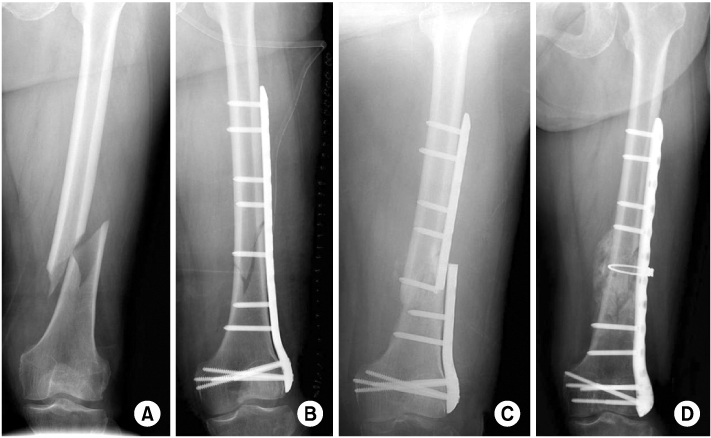J Korean Fract Soc.
2011 Oct;24(4):321-327.
Treatment of Distal Femoral Fractures Using Polyaxial Locking Plate
- Affiliations
-
- 1Department of Orthopedic Surgery, Daejeon St. Mary's Hospital, The Catholic University of Korea College of Medicine, Daejeon, Korea. weonkim@hotmail.com
Abstract
- PURPOSE
To report the clinical outcome of polyaxial locking plate (Noncontact bridging (NCB) plate (Zimmer, Warsaw, Indiana)) for the treatment of distal femur fracture with minimal invasive percutaneous periosteal osteosynthsis (MIPPO) technique.
MATERIALS AND METHODS
Between February 2008 to April 2010, twenty six patients (11 men, 15 women), twenty eight cases diagnosed as distal femoral fractures are enrolled in this retrospective study. The mean age of the patients was 63 years (34 to 85) and the mean follow-up was 20.3 months (12 to 32). According to the AO/ASIF classification, 15 fractures were type A, 1 type B and 9 type C. And there were 3 periprsthetic fractures around knee. The analysis of the clinical and radiologic outcome were performed by Sanders functional evaluation scale and radiologic follow up after operation, respectively.
RESULTS
Among 28 cases, 25 cases united without additional operation. According to Sanders functional evaluation scale, there were 11 excellent, 9 good, 4 fair, 2 poor. As complications, there were 1 knee stiffness, 1 delayed union, 1 implant failure with refracture, 1 implant loosening. Three patients except one knee stiffness, underwent a second LISS plating using NCB plate and and bone grafting, resulting in a satisfactory final outcome.
CONCLUSION
Internal fixation using polyaxial locking plate with MIPO technique may be one of the most effective methods for the treatment of distal femoral fractures.
MeSH Terms
Figure
Reference
-
1. Apostolou CD, Papavasiliou AV, Aslam N, Handley RC, Willett KM. Preliminary results and technical aspects following stabilisation of fractures around the knee with liss. Injury. 2005. 36:529–536.
Article2. Bong MR, Egol KA, Koval KJ, et al. Comparison of the LISS and a retrograde-inserted supracondylar intramedullary nail for fixation of a periprosthetic distal femur fracture proximal to a total knee arthroplasty. J Arthroplasty. 2002. 17:876–881.
Article3. Button G, Wolinsky P, Hak D. Failure of less invasive stabilization system plates in the distal femur: a report of four cases. J Orthop Trauma. 2004. 18:565–570.
Article4. Connolly JF, Dehne E, Lafollette B. Closed reduction and early cast-brace ambulation in the treatment of femoral fractures. II. Results in one hundred and forty-three fractures. J Bone Joint Surg Am. 1973. 55:1581–1599.
Article5. Figgie MP, Goldberg VM, Figgie HE 3rd, Sobel M. The results of treatment of supracondylar fracture above total knee arthroplasty. J Arthroplasty. 1990. 5:267–276.
Article6. Firoozbakhsh K, Behzadi K, DeCoster TA, Moneim MS, Naraghi FF. Mechanics of retrograde nail versus plate fixation for supracondylar femur fractures. J Orthop Trauma. 1995. 9:152–157.
Article7. Haidukewych G, Sems SA, Huebner D, Horwitz D, Levy B. Results of polyaxial locked-plate fixation of periarticular fractures of the knee. Surgical technique. J Bone Joint Surg Am. 2008. 90:117–134.
Article8. Helfet DL, Lorich DG. Retrograde intramedullary nailing of supracondylar femoral fractures. Clin Orthop Relat Res. 1998. 350:80–84.
Article9. Kanabar P, Kumar V, Owen PJ, Rushton N. Less invasive stabilisation system plating for distal femoral fractures. J Orthop Surg (Hong Kong). 2007. 15:299–302.
Article10. Kim JJ. Treatment of distal femur fracture. J Korean Fract Soc. 2005. 18:213–220.
Article11. Kobbe P, Klemm R, Reilmann H, Hockertz TJ. Less invasive stabilisation system (LISS) for the treatment of periprosthetic femoral fractures: a 3-year follow-up. Injury. 2008. 39:472–479.
Article12. Koval KJ, Hoehl JJ, Kummer FJ, Simon JA. Distal femoral fixation: a biomechanical comparison of the standard condylar buttress plate, a locked buttress plate, and the 95-degree blade plate. J Orthop Trauma. 1997. 11:521–524.
Article13. Marti A, Fankhauser C, Frenk A, Cordey J, Gasser B. Biomechanical evaluation of the less invasive stabilization system for the internal fixation of distal femur fractures. J Orthop Trauma. 2001. 15:482–487.
Article14. Mize R. Treatment options for fractures of the distal femur. Instr Course Lect. 1994. 43:109–117.15. Mize RD, Bucholz RW, Grogan DP. Surgical treatment of displaced, comminuted fractures of the distal end of the femur. J Bone Joint Surg Am. 1982. 64:871–879.
Article16. Ochsner PE, Pfister A. Use of the fork plate for internal fixation of periprosthetic fractures and osteotomies in connection with total knee replacement. Orthopedics. 1999. 22:517–521.17. Oh JK, Oh CW, Park SH, Roh KJ, Jeong CW. Conformity of the LCP-DF (Locking Compression Plate-Distal Femur) in Korean adult femur: a cadaver study. J Korean Fract Soc. 2005. 18:399–404.
Article18. Otto RJ, Moed BR, Bledsoe JG. Biomechanical comparison of polyaxial-type locking plates and a fixed-angle locking plate for internal fixation of distal femur fractures. J Orthop Trauma. 2009. 23:645–652.
Article19. Sanders R, Swiontkowski M, Rosen H, Helfet D. Double-plating of comminuted, unstable fractures of the distal part of the femur. J Bone Joint Surg Am. 1991. 73:341–346.
Article20. Schandelmaier P, Partenheimer A, Koenemann B, Grün OA, Krettek C. Distal femoral fractures and LISS stabilization. Injury. 2001. 32:SC55–SC63.
Article21. Schatzker J, Lambert DC. Supracondylar fractures of the femur. Clin Orthop Relat Res. 1979. 138:77–83.
Article22. Schütz M, Müller M, Regazzoni P, et al. Use of the less invasive stabilization system (LISS) in patients with distal femoral (AO33) fractures: a prospective multicenter study. Arch Orthop Trauma Surg. 2005. 125:102–108.
Article23. Smith TO, Hedges C, MacNair R, Schankat K, Wimhurst JA. The clinical and radiological outcomes of the LISS plate for distal femoral fractures: a systematic review. Injury. 2009. 40:1049–1063.
Article24. Stoffel K, Lorenz KU, Kuster MS. Biomechanical considerations in plate osteosynthesis: the effect of plate-to-bone compression with and without angular screw stability. J Orthop Trauma. 2007. 21:362–368.
Article25. Syed AA, Agarwal M, Giannoudis PV, Matthews SJ, Smith RM. Distal femoral fractures: long-term outcome following stabilisation with the LISS. Injury. 2004. 35:599–607.
Article26. Wilkens KJ, Curtiss S, Lee MA. Polyaxial locking plate fixation in distal femur fractures: a biomechanical comparison. J Orthop Trauma. 2008. 22:624–628.
Article27. Wong MK, Leung F, Chow SP. Treatment of distal femoral fractures in the elderly using a less-invasive plating technique. Int Orthop. 2005. 29:117–120.
Article
- Full Text Links
- Actions
-
Cited
- CITED
-
- Close
- Share
- Similar articles
-
- Comparison of Results of Minimally Invasive Plate Osteosynthesis according to Types of Locking Plate in Distal Femoral Fractures
- Medial Plating of Distal Femoral Fracture with Locking Compression Plate-Proximal Lateral Tibia: Cases' Report
- Failure of Distal Locking Screws in an Intraarticular Distal Radius Fracture Treated with Volar Locking Plate Fixation
- Treatment of Distal Femur Fracture with Minimally Invasive Locking Compression Plate Osteosynthesis
- Effect of Additional Medial Locking Plate Fixation and Autogenous Bone Graft for Distal Femur Nonunion after Lateral Locking Plate Fixation




